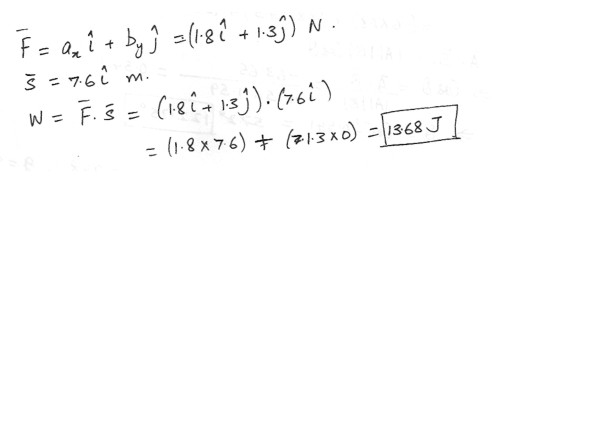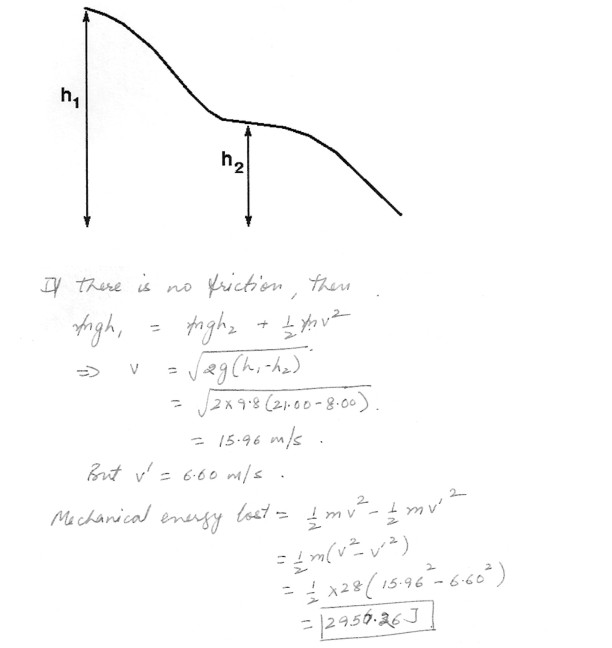Physics Work,Power & Energy Level: High School
A cart loaded with a bricks has a total mass of 9.35 kg and is pulled at constant speed by a rope . The rope is inclined at 24.4 degrees above the horizontal floor. The coefficient of kinetic friction between ground and cart is 0.734 . The acceleration of gravity is 9.8 m/s2. How much work is done on the cart by the rope ? Answer in units of kJ .
Physics Work,Power & Energy Level: High School
A force F is exerted by a broom handle on the head of the bottom , which has a mass m . The angle is at an angle theta to the horizontal . What is the work done by the force on the head of the boom as it moves a distance d across a horizontal force ?a) W = F d Sin theta
b) W = Fm Cos theta
c) W = Fm Tan theta
d) W = Fmd Sin theta
e) W = Fd Cos theta

Physics Work,Power & Energy Level: High School
A student , later for class , ran up some stairs between landings . The landing are 11.2 m apart . The student has a mass of 51.6 kg and it took 6.88 s to do the run . The acceleration of gravity is 9.8 m/s2 . What is the average power that the student was generating during the run ? Answer in units of W .
Physics Work,Power & Energy Level: High School
A box of mass m with an initial velocity of vo slides down a plane , inclined at theta with respect to the horizontal . The coefficient of kinetic friction is mu . The box stops after sliding a distance x . How far does the box slide ?a) X = v0 squared /g (mu Sin theta -2 Cos theta)
b) X = v0 squared / 2g( mu Cos theta + Sin theta )
c) X = v0 squared /2g sin theta
d) X = v0 squared/g (mu Sin theta + Cos theta )
e) X = v0 squred/2g (mu Sin theta – Cos theta )
f) X = v0 squared /2g (mu Cos theta – Sin theta )
g) X = v0 squared/2g (Sin theta- mu Cos theta)
h) X = v0 squared/2g (mu Sin theta + Cos theta )
i) X = v0 squared / g ( Sin theta – mu Cos theta )
j) X = v0 squred / 2g mu Cos theta

Physics Work,Power & Energy Level: High School
A mass of 0.25 kg is initially at rest on a horizontal surface . A force , given by F = Fxi , acts on the mass . The horizontal component Fx is plotted below as a function of position along the x axes . The coefficient of kinetic friction is 0.035 . The acceleration of gravity is 9.8 m/s2 . Calculate the kinetic energy K of the mass as it reaches 6 m . Answer in units of J .
Physics Work,Power & Energy Level: High School
A force F = axi + byj where a = 1.8 N/m and b = 1.3 N/m , acts on an object moves in the I direction along the x axis from the original to C = 7.6 m . Find the work done on the object by the force . Answer in units of J .
Physics Work,Power & Energy Level: High School
A force F = Fxi, Fxj acts on an object with Fx = 4 N and Fy = 4 N . The angle between F and the displacement vector, s, is 21 degrees , and 85.9 J of work is done by F , Find the magnitude of S . Answer in units of m .

Physics Work,Power & Energy Level: High School
A skier traveling 13.0 m/s reaches the foot of a steady upward 16.4 incline and glides 12.7 m up along this slope before coming to rest . What was the average coefficient of friction ?
Physics Work,Power & Energy Level: High School
A child slides down a long slide in a playground . She starts from rest at a height h1 of 21.00 m . When she is patway down the slide , at a height h2 of 8.00 m , she is moving at a speed of 6.60 m/s . Calculate the mechanical energy lost due to friction (as heat, etc.)
Physics Work,Power & Energy Level: High School
A 72.0 kg bungee jumper jumps from a bridge . She is tied to a 10.2 m long bungee cord and falls a total of 33.0 cm . Calculate the spring constant k of the bungee cord .
Physics Work,Power & Energy Level: High School
In the high jump , the kinetic energy of an athlete is transformed into gravitational potential energy without the aid of a pole . With what minimum speed must the athlete leave the ground in order to lift his center of mass 2.02 m and cross the bar with a speed of 0.680 m/s ?
Physics Work,Power & Energy Level: High School
Two identical massless springs of constant k = 250 N/m are fixed at opposite ends of a level track , as shown in the figure at “click here”A 4.96 kg block I pressed against the left spring , compressing it by 0.180 m . The block (initially at rest) is then released, (a) The entire track is frictionless except for the section between A and B . Given that the coefficient of kinetic friction between block and track along AB is mu^k = 0.0850 , and given that the length AB is 0.210 m, determine the maximum compression of the spring on the right (b) .

Physics Work,Power & Energy Level: High School
The figure at “click here” show masses sliding down a frictionless incline . All masses start from rest ; the mass of each block is given near the top of each figure , the height of the incline is given on the left , and the length of the incline is given on the right .Which of the following statements are true about the situation depicted in the figures .
The final velocity of the mass in picture B is greater than the one of the mass in picture F.
The final kinetic energy (when they reach the bottom of the incline ) is greater in picture A than in picture B .
The initial potential energy of the mass is greater in picture A than in picture E.
The larger the height of the incline , the larger the potential energy of the mass at the top of the incline .
Half-way down the incline , the potential energy is equal to half the total energy .

Physics Work,Power & Energy Level: High School
The launching mechanism of a toy gun of a spring of unknown spring constant , as shown in the figure at “click here” . If the spring is compressed a distance of 0.140 m and the gun fired vertically as shown in the figure at “click here” , the gun can launch a 17.0 g projectile from rest to a maximum height of 15.1 m above the string point of the projectile . Neglecting all resistive force ,(i) Determine the spring constant
(ii) Determine the speed of the projectile as it moves through the equilibrium position of the spring (where x = 0 )

Physics Work,Power & Energy Level: High School
A 0.410 kg bead slides on a curved wire , starting from rest at point A as seen in the figure at ‘click here’ . Assume h1 = 6.00 m and h2 = 2.77 m . If the wire is frictionless(a) Find the speed of the bead at B .
(b) If wire is frictionless , find the speed of the bead at C .

